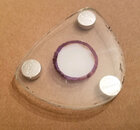dmaziuk
Contributor
Cressi big eyes has user-removable glass (hint, hint). I'm not donating mine to science though, sorry, I only have one.
Welcome to ScubaBoard, the world's largest scuba diving community. Registration is not required to read the forums, but we encourage you to join. Joining has its benefits and enables you to participate in the discussions.
Benefits of registering include
Sweet.Cressi big eyes has user-removable glass (hint, hint).
?? it is on their website, and in my two local Giants. They call it "Clear Ammonia All Purpose Cleaner."But wait, ammonia and oil is just so much easier since they are grocery store items, and the last step is the dishwasher so cleanup won't be too bad.
Since I'm going to Giant today, I'll give it a try anyway ...
OK, WTH! They don't have ammonia?!
Sweet.
One question. Did you flame, toothpaste, or just deal with the lenses until they became seasoned? Or maybe (as that mask is not 'frameless') it came reasonably seasoned right out of the box?

@-JD-,
I think that I'm on to something: Mix toothpaste (Arm & Hammer) with Baker's Grade Ammonium Bicarbonate, 1:1. Carefully add water to just make a sticky paste. Apply to inner surface of lens and wait several days. Leave mask in the open air so that no ammonia can harm the hard plastic parts.
That particular toothpaste is formulated with sodium bicarbonate. We are adding another bicarbonate salt, that of ammonia. They appear to be compatible. The ammonium salt slowly decomposes to ammonia, water, and carbon dioxide when wet. The toothpaste is only there to keep the ammonium salt stuck to the lens and moist so that it continues to release small amounts of gaseous ammonia.
I'll let you know how well this paste holds up in open air. Trying for some concoction that will last three days or so. I just bought two factory fresh masks for the final >sigh< attempt...
View attachment 686668
The pic above is NOT the lens from a new mask. It is an adhesion/drying test on an old failed mask.
I press on in order to take advantage of ammonia without subjecting any parts of the mask to this chemical, just the inner lens surfaces. I'm looking for a process that can be done in the open air so that any small amounts of released ammonia gas can quickly diffuse away.
I use a little Bon Ami cleanser. Wet the mask, sprinkle some in, work it around with a paper towel and rinse it out well. Bon Ami will get glass cleaner than any other method.
It will also work to remove even the most stubborn water spots and mineral deposits on automotive glass (on any glass).
Bon Ami is what we use to get glass absolutely clean so we can do water gilding gold leaf signs on windows. The water must “sheet out” and can’t have any contamination whatsoever. Bon Ami is the only thing that works. It also has no chlorine, perfumes, dyes, or any other dangerous chemicals.
